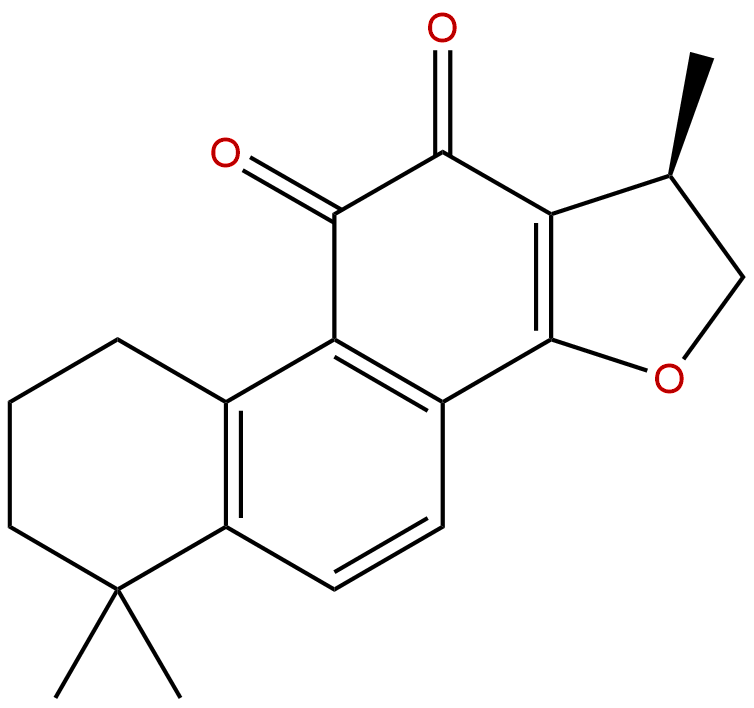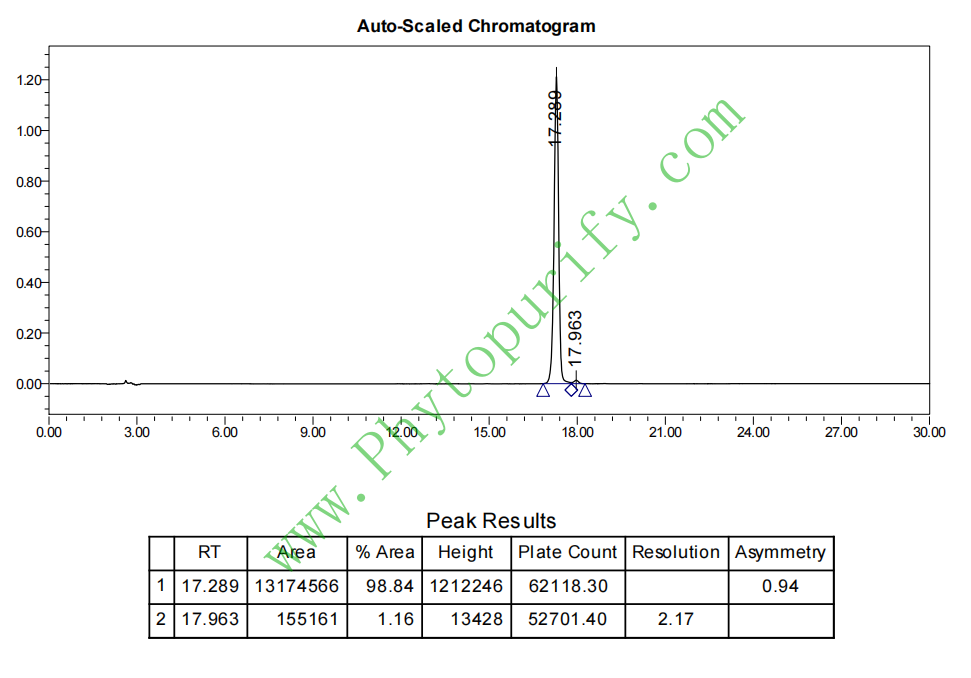
CryptotanshinoneCAS No.:35825-57-1
|
||||||||||
 |
|
|
||||||||

| Catalogue No.: | BP0412 |
| Formula: | C19H20O3 |
| Mol Weight: | 296.366 |
Product name: Cryptotanshinone
Synonym name:
Catalogue No.: BP0412
Cas No.: 35825-57-1
Formula: C19H20O3
Mol Weight: 296.366
Botanical Source: root of Salvia miltiorrhiza and from Rosmarinus officinalis (rosemary) and Meriandra benghalensis
Physical Description: Red powder
Type of Compound: Diterpenoids
Purity: 95%~99%
Analysis Method: HPLC-DAD or/and HPLC-ELSD
Identification Method: Mass, NMR
Packing: Brown vial or HDPE plastic bottle
Storage: Store in a well closed container, protected from air and light. Put into refrigerate or freeze for long term storage.
Whenever possible, you should prepare and use solutions on the same day. However, if you need to make up stock solutions in advance, we recommend that you store the solution as aliquots in tightly sealed vials at -20℃. Generally, these will be useable for up to two weeks.
The product could be supplied from milligrams to grams, up to kilograms
Inquire for bulk scale.
Descriptions:
Cryptotanshinone9(CT), the major tanshinone isolated from Salvia miltiorrhiza Bunge, can suppress Bcl-2 expression and augment Fas sensitivity in DU145 cells, and JNK and p38 MAPK act upstream of Bcl-2 expression in Fas-treated DU145 cells; CT significantly blocks activation of these kinases and sensitizes several tumor cells to a broad range of anti-cancer agents; suggests that CT has therapeutic potential in the treatment of human prostate cancer.[1]
Cryptotanshinone has an inhibitory effect on MMP-9 production and migration of human aortic smooth muscle cells treated with TNF-alpha in a dose-dependent manner, suggests that CT has anti-atherosclerosis and anti-neointimal formation activity.[2]
Cryptotanshinone enhances TNF-α-induced apoptosis in chronic myeloid leukemia KBM-5 cells, in comparison with the treatment with either drug alone, the treatment with cryptotanshinone further suppressed TNF-α-mediated expression of c-FLIP.[3]
Cryptotanshinone as an AR inhibitor to suppress androgen/AR-mediated cell growth and PSA expression by blocking AR dimerization and the AR-coregulator complex formation; and CT effectively inhibits CWR22Rv1 cell growth and expressions of AR target genes in the xenograft animal model; the previously un-described mechanisms of CT may explain how CT inhibits the growth of prostate cancer (PCa)cells and help us to establish new therapeutic concepts for the treatment of PCa.[4]
Cryptotanshinone induces ER stress-mediated apoptosis in HepG2 and MCF7 cells , also evidences sensitizing effects to a broad range of anti-cancer agents including Fas/Apo-1, TNF-α, cisplatin, etoposide or 5-FU through inducing ER stress, highlighting the therapeutic potential in the treatment of human hepatoma and breast cancer.[5]
Cryptotanshinone protects primary cortical neurons from -induced neurotoxicity through the activation of /pathway, such neuroprotective effects may be of interest in AD and other .[6]
Cryptotanshinone can inhibits cyclooxygenase-2 enzyme activity.[7]
References:
[1] Park I J, Kim M J, Park O J, et al. Cancer Lett, 2010, 298(1):88-98.
[2] Suh S J, Jin U H, Choi H J, et al. Biochem Pharmacol 2007, 72(12):1680-9.
[3] Kim J H, Jeong S J, Kwon T R, et al. Apoptosis, 2011, 16(7):696-707.
[4] Xu D, Lin T H, Li S, et al. Cancer Lett, 2012, 316(1):11-22.
[5] Park I J, Kim M J, Park O J, et al. Apoptosis An Int J on Programmed Cell Death, 2012, 17(3):248-57.
[6] Zhang F, Zheng W, Pi R, et al. Exp Brain Res, 2008, 193(1):109-18.
[7] Jin D Z, Yin L L, Ji X Q, et al. Eur J Pharmacol, 2006, 549(1–3):166-72.
[8] Xiao-Li L I, Xiao-Rong L I, Wang L J, et al. Chinese Trad Patent Med, 2008, 30(1):77-80.
HPLC of Cryptotanshinone
